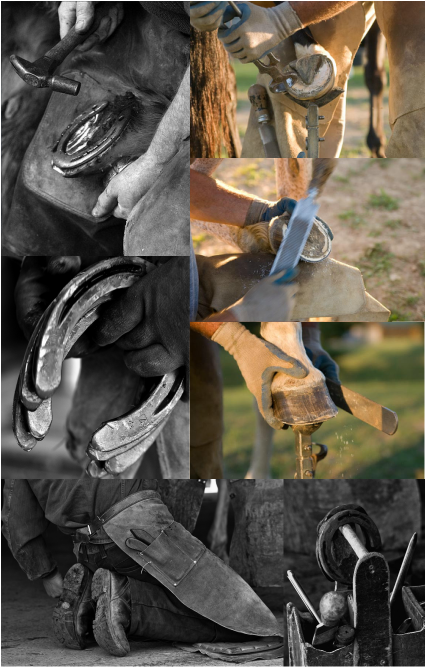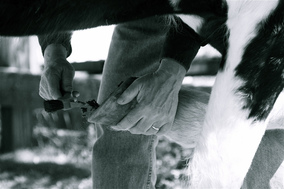To Shoe or Not To Shoe?
|
|
|
As you can see, there are advantages to both shoeing your horse and keeping it barefoot. Which you choose should depend on your horse's hoof condition, the type of riding that you do, and the season/turn-out environment. For example, if you have a pleasure horse who is ridden primarily in sanded arenas or on trails with flat/soft terrain, then leaving them barefoot may save you some money as well as keep your horses' hooves clean and tough. However, good barefoot candidates are those that have strong and sound feet, so it is best to ask your farriers opinion when deciding.
It is also important to consider your horse's turn-out conditions. If they are living out on pasture, it may be best to keep them barefoot because the bare hoof is better equipted to self-clean, release excess moisture, and will toughen up (safer for varied terrain than if they toss a shoe and you don't notice it for a few days). This is especially true during the Winter, when show and ice can gather in shoes causing discomfort, imbalance, bruising and even abscesses. In addition, horses shod in the back can injure other horse's they're turned out with and are therefore usually restricted to individual turn-out. On the other hand, shoes can provide increased traction, balance, support, and overall protection. Competition horses, those living/working on rough terrain, and ones with hoof injuries or confirmation flaws can really benefit from shoes and there are an enormous variety to choose from. Again, your farrier is best equipped to answer any questions you may have regarding whether or not to shoe your horse and, if you do, what type of shoe is best. However, if you decide to keep your previously shod horse bare, remember that their hooves will be quite tender at first. Putting protective boots on your horse while riding in the beginning can help them transition without going lame. There are also a few management techniques that can benefit your horse's hooves in general. Keeping their environment dry, by cleaning stalls/paddocks regularly and considering alternative drainage or footing when necessary. This is important because wet conditions can lead to soft and weak hooves as well as predispose your horse to developing bacterial infections such as thrush. If conditions are too dry, horses hooves may become brittle or cracked. However, there are numerous hoof moisturizers available to help prevent this (if you find that their heel is becoming dry, petroleum jelly can be rubbed into it). Nutrition can play a huge role in hoof growth and condition. Vitamins A and D, as well as copper, manganese, and calcium are all important for healthy hooves. Zinc can also improve hoof condition, by preventing the destruction of keratin (Moore, 1989). Adding limestone flour, rice bran or cod liver oil to your horse's diet can help ensure that these mineral needs are met as well as provide beneficial amino acids. In addition, supplementing with 20mg of biotin daily has been shown to significantly increase hoof horn growth, as well as aid in an overall healthy coat (Black, 1985 and FeedMixMagazine). |
|
Daily Care
|
It is important to clean your horse's hooves regularly in order to prevent the build-up of dirt and bacteria. Such build-up could lead to the development of infections such as thrush. In addition, stones and other foreign objects can become wedged in the horse's hoof and cause a bruised sole. Puncture wounds or cracking of the hoof wall can lead to permanent damage if not addressed quickly, and a tossed shoe can cause a horse to go lame if it goes unnoticed. Picking your horse's hooves daily will reduce the risk of these things happening, as well as give you the opportunity to monitor the general state of their hooves or shoes. Look for signs that you're horse is due to be reshod, such as uneven wear, a loose nail or clinch, and flares/dishes. |


